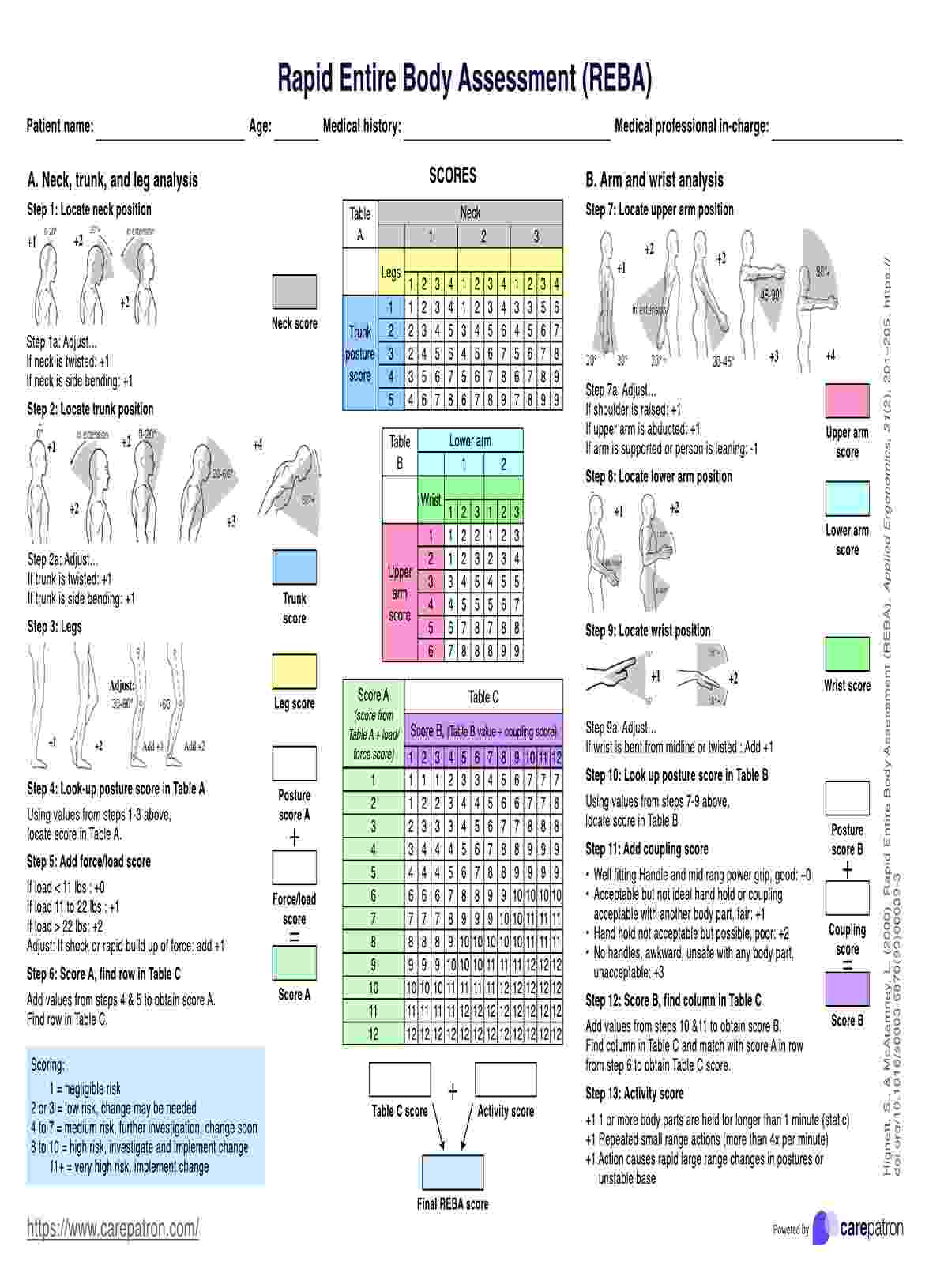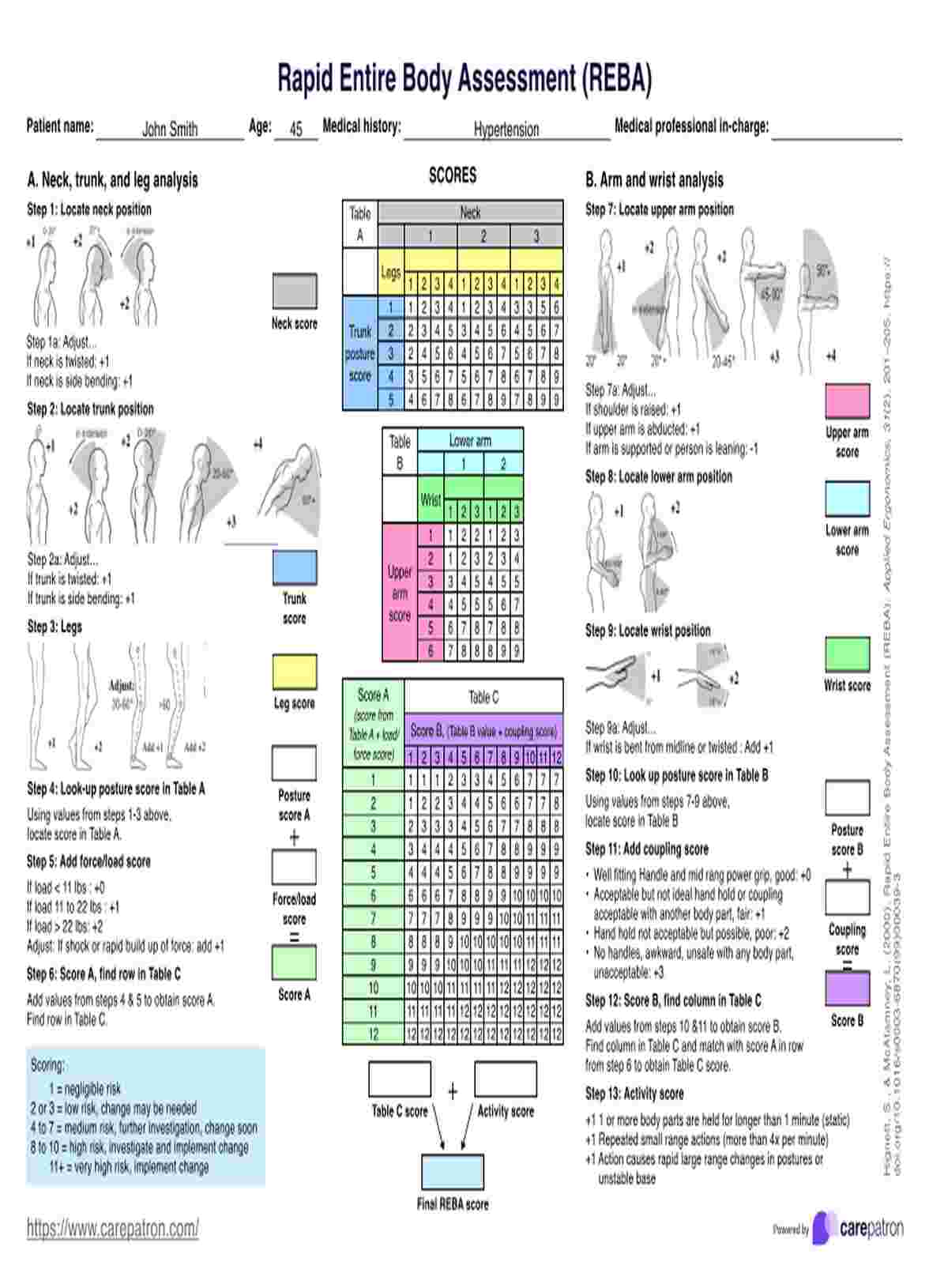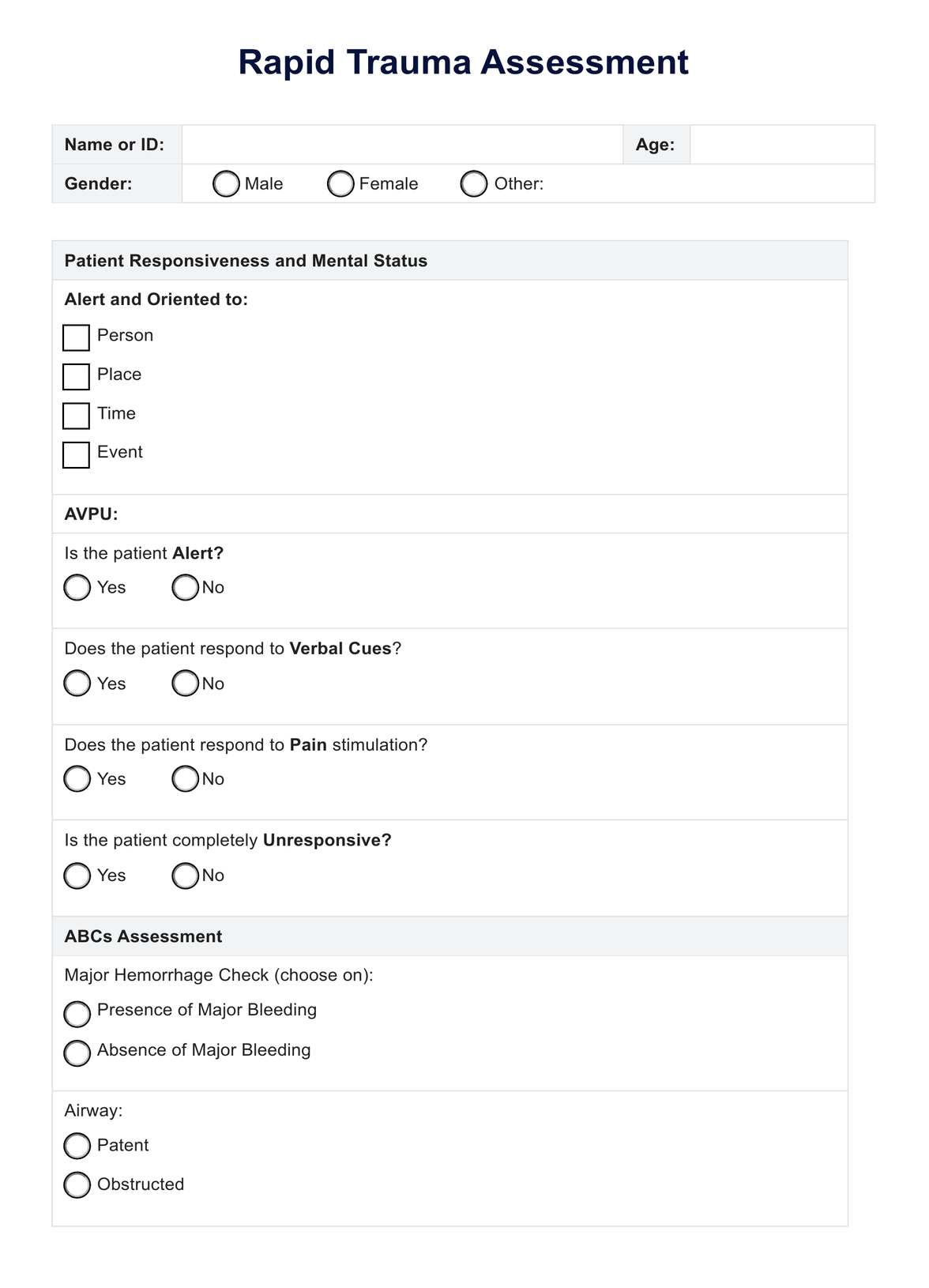Rapid Entire Body Assessment
Discover the Rapid Entire Body Assessment & example on our website! Get Carepatron's free PDF and learn more about this body assessment method.


What are work-related musculoskeletal disorders (WRMSDs)?
Work-related musculoskeletal disorders (WRMSDs) encompass a spectrum of conditions affecting muscles, tendons, ligaments, nerves, and joints due to occupational activities. These disorders result from repetitive movements, prolonged awkward postures, forceful exertions, and manual workplace handling tasks. WRMSDs are prevalent across industries and impact workers' health, productivity, and quality of life.
To mitigate WRMSDs, organizations employ different ergonomic assessment methods such as the Rapid Entire Body Assessment (REBA), rapid upper limb assessment, and manual handling assessment charts. These tools evaluate biomechanical and musculoskeletal disorder (MSD) risks associated with specific tasks and postures. The REBA method, for instance, assesses postural risk factors comprehensively, considering entire body posture, force exertion, and task duration.
Addressing WRMSDs involves considering ergonomic principles and human factors in workspace design and task allocation. Identifying and modifying factors contributing to musculoskeletal strain can reduce the incidence of WRMSDs and enhance workplace safety and efficiency.
Common examples of WRMSDs
WRMSDs encompass a variety of conditions that affect the musculoskeletal system due to occupational activities. Here are some common examples:
- Lower back pain: Often caused by heavy lifting, prolonged sitting, or poor posture.
- Carpal tunnel syndrome: Characterized by numbness, tingling, and weakness in the hand and wrist, commonly associated with repetitive hand movements.
- Tendinitis/tendonitis: Inflammation of tendons, commonly affecting the shoulders, elbows, wrists, or knees due to repetitive motions or overuse.
- Rotator cuff injuries Result from repetitive overhead movements or lifting heavy objects, leading to pain and a limited range of motion in the shoulder.
- Neck strain: Caused by prolonged periods of looking down at screens or maintaining awkward neck positions.
- Epicondylitis (tennis/golfer's elbow): Inflammation of the tendons in the elbow due to repetitive gripping or wrist movements.
These examples illustrate the diverse range of WRMSDs arising from various occupational tasks and environments. Both employers and employees need to recognize the risk factors associated with these conditions and take proactive measures to prevent their occurrence.
Common symptoms
Work-related musculoskeletal disorders can manifest through a range of symptoms, often affecting different parts of the body. Here are some common symptoms to watch out for:
- Pain: Persistent or intermittent pain in the affected area, ranging from dull aches to sharp, shooting pains.
- Stiffness: Reduced flexibility and mobility in muscles and joints, particularly after prolonged periods of inactivity or repetitive movements.
- Numbness and tingling: Sensations of numbness, tingling, or pins and needles in the hands, arms, legs, or feet, indicating nerve compression or irritation.
- Weakness: Decreased strength and muscle function, making it difficult to perform tasks that were previously manageable.
- Swelling: Inflammation and swelling in the affected area, often accompanied by redness and warmth to the touch.
- Fatigue: Excessive tiredness or fatigue, especially in the muscles and joints involved in repetitive tasks.
- Loss of function: Difficulty performing everyday activities due to pain, stiffness, or weakness, impacting overall quality of life.
Recognizing these symptoms early on can help individuals seek appropriate medical attention and interventions to prevent further progression of WRMSDs and minimize their impact on daily activities and work performance.
Common risk factors and causes
Common risk factors and causes associated with the Rapid Entire Body Assessment include repetitive motions, prolonged awkward postures, forceful exertions, and manual handling tasks. These risk factors can lead to musculoskeletal strain and injury among workers, particularly in occupations that involve repetitive or strenuous activities.
Poor workstation ergonomics, inadequate training on proper lifting techniques, and high job demands are additional contributors to postural risks assessed by REBA. Furthermore, individual factors such as age, fitness level, and pre-existing musculoskeletal conditions can also increase susceptibility to ergonomic injuries.
Identifying and addressing these risk factors through REBA assessments can help organizations implement targeted interventions to prevent work-related musculoskeletal disorders and promote a safer work environment for employees.
Rapid Entire Body Assessment Template
Rapid Entire Body Assessment Example
What is a Rapid Entire Body Assessment (REBA)?
REBA is an ergonomic assessment method designed to evaluate postural risk factors associated with various work tasks. It provides a systematic approach to assessing the ergonomic demands placed on the entire body during task performance. The REBA method considers factors such as posture, force exertion, and task duration to determine the level of musculoskeletal risk posed to workers.
During a REBA assessment, trained evaluators observe workers performing specific tasks and assign scores based on predefined criteria. These scores are then used to calculate an overall REBA score, which indicates the level of postural risk associated with the task. The higher the REBA score, the greater the risk of musculoskeletal strain or injury.
REBA assessments typically involve observing workers in real work environments and may include postural assessments using tools such as photographs or video recordings. By conducting REBA assessments, organizations can identify ergonomic hazards and implement appropriate interventions to reduce the risk of WRMSDs and improve workplace safety and efficiency. Overall, the REBA is a valuable tool in promoting ergonomic awareness and preventing musculoskeletal injuries in various industries.
How is this conducted?
Conducting a REBA involves several systematic steps to evaluate postural risk factors associated with work tasks. Here's an overview of how the assessment is conducted:
- Task identification: Identify the specific work task or activity to be assessed for ergonomic risk factors.
- Observation and posture analysis: Observe workers performing the task in their actual work environment, noting postures, movements, and force exertion. Analyze the posture of workers using standardized criteria, considering factors such as joint angles, trunk position, and upper limb orientation.
- General assessment: Assess the force exerted by workers during the task, including lifting, pushing, pulling, or gripping actions. Determine the duration of the task and frequency of repetitive movements to assess cumulative exposure to ergonomic risk factors.
- Scoring, calculation, and interpretation: Assign scores to various components of the assessment based on predetermined criteria, including posture, force exertion, and task duration. Calculate an overall REBA score based on the individual scores assigned to each component of the assessment. Interpret the REBA score to determine the level of postural risk associated with the task and identify areas for ergonomic improvement.
- Recommendations: Provide recommendations for ergonomic interventions or modifications to reduce the risk of musculoskeletal injury and improve worker safety and comfort.
How are the results scored and interpreted?
After conducting a REBA, the results are scored and interpreted to determine the level of postural risk associated with the assessed task. These scores are then used to calculate an overall REBA score, which serves as an indicator of the task's postural risk level.
A higher REBA score suggests a greater risk of musculoskeletal strain or injury to workers, indicating the need for ergonomic interventions or modifications to improve safety and comfort. Conversely, a lower score signifies a lower postural risk associated with the task, but ongoing vigilance and monitoring are still essential to maintain a safe work environment. Continuous reassessment is needed to ensure compliance with ergonomic principles and address any changes in task conditions or worker behaviors.
Organizations can proactively mitigate ergonomic risk factors and prioritize worker health and safety by effectively scoring and interpreting the results of a REBA assessment.
How to use our Rapid Entire Body Assessment template
Using Carepatron's REBA template is straightforward and can greatly enhance the efficiency of ergonomic assessments in healthcare settings. Here's a step-by-step guide on how medical professionals can utilize the template effectively:
Step 1: Access the template
Once you're in your Carepatron account, look for the REBA template in our resource library.
Step 2: Task identification
Identify the specific task or activity to be assessed for ergonomic risk factors.
Step 3: Observation and data collection
Observe the healthcare worker performing the task, noting postures, movements, and force exertion. Use the REBA template to systematically record relevant data, including posture, force exertion, and task duration.
Step 4: Score calculation
Input the collected data into the REBA template to calculate scores for each assessment component. The template automatically generates an overall REBA score based on the inputted data.
Step 5: Interpretation and action planning
Interpret the REBA score to determine the level of postural risk associated with the task. Based on the assessment findings, develop action plans for ergonomic interventions or modifications to mitigate identified risks.
Step 6: Documentation and reporting
Document the assessment results and action plans within the Carepatron platform for future reference. Generate reports summarizing the assessment findings and recommended interventions for stakeholders' review.
Step 7: Follow-up and monitoring
Monitor the effectiveness of implemented interventions and reassess ergonomic risks periodically. Use the REBA template to track changes in postural risk levels over time and adjust interventions as needed.
Benefits of conducting the REBA assessment
The REBA is a valuable ergonomic assessment tool with numerous benefits for enhancing workplace safety and employee well-being. Here are five key advantages of conducting the REBA assessment:
Comprehensive analysis
The REBA assessment provides a systematic process for formally analyzing ergonomic risk factors associated with job tasks. By evaluating postural data and upper limb movements, the REBA method enables a thorough assessment of musculoskeletal strain risks across the entire body.
Enhanced human health
By identifying and addressing ergonomic risk factors, the REBA assessment helps prevent musculoskeletal injuries and promotes better overall health and well-being among workers. Implementing ergonomic interventions based on REBA findings can reduce the incidence of work-related injuries and associated health issues.
Applicability across industries
The versatility of the REBA method makes it suitable for use in various industries, including manufacturing, healthcare, service industries, and developing countries. Regardless of the job task or workplace setting, the REBA assessment can be adapted to assess ergonomic risks effectively.
Actionable insights
With its ability to generate posture scores and a final REBA score, the assessment provides actionable insights for implementing targeted ergonomic interventions. Organizations can improve workplace safety and comfort by addressing identified risk factors, leading to increased productivity and employee satisfaction.
Cost-effective solution
Conducting regular REBA assessments can ultimately save organizations money by reducing the occurrence of work-related injuries and associated healthcare costs. Investing in ergonomic assessments and interventions protects employee health and contributes to the long-term sustainability of businesses.
Treatments for work-related musculoskeletal disorders
WRMSDs can cause discomfort, pain, and limitations in daily activities. Fortunately, various treatments can help alleviate symptoms and improve function for individuals affected by these conditions. Here are several effective treatments for WRMSDs:
Physical therapy
Physical therapy aims to improve flexibility, strength, and range of motion in affected muscles and joints. Therapeutic exercises, manual therapy techniques, and heat and cold therapy can help reduce pain and restore function.
Ergonomic modifications
Making ergonomic modifications to workstations and job tasks can help reduce the strain on muscles and joints, alleviating symptoms of WRMSDs. Adjusting chair height and desk ergonomics and using proper lifting techniques can significantly improve workplace comfort and safety.
Pain management techniques
Pain management techniques, including medication, acupuncture, massage therapy, and transcutaneous electrical nerve stimulation (TENS), can help alleviate pain associated with WRMSDs. These treatments can provide temporary relief while individuals work on addressing the underlying causes of their symptoms.
Rest and activity modification
Resting and modifying activity levels can help individuals manage symptoms of WRMSDs. Balancing periods of activity with adequate rest breaks can prevent overexertion and allow time for healing.
Education and self-care
Educating individuals about proper body mechanics, ergonomic principles, and self-care strategies can empower them to manage their WRMSDs effectively. Techniques such as stretching, strengthening exercises, and stress management can complement other treatments and promote long-term symptom relief.
Commonly asked questions
The Rapid Entire Body Assessment (REBA) is an ergonomic assessment method used to evaluate postural risks associated with various work tasks by considering factors such as posture, force exertion, and task duration.
Some disadvantages of Rapid Entire Body Assessment (REBA) include its reliance on subjective judgment for scoring, potential for variability in assessment results among evaluators, and limited applicability to certain job tasks or industries.
While both RULA (Rapid Upper Limb Assessment) and Rapid Entire Body Assessment (REBA) assess ergonomic risks, RULA focuses specifically on upper limb postures, while REBA evaluates postural risks across the entire body.








































































































